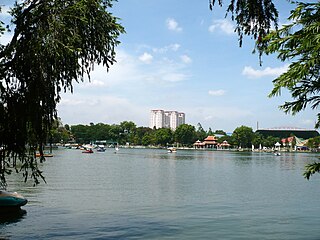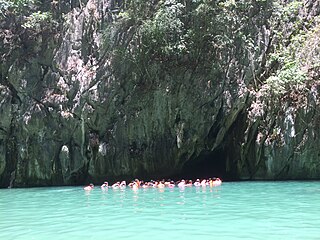Related Research Articles

Điện Biên is a province in the Northwest region of Vietnam. It is bordered by Lai Châu to the northeast, Sơn La to the southeast, Pu'er City, Yunnan, China, to the northwest, and Phongsaly province in Laos to the west. The province covers an area of 9,541 square kilometres and as of 2019 it had a population of 598,856 people.

Gigantopithecus is an extinct genus of ape that lived in southern China from 2 million to approximately 300-200,000 years ago during the Early to Middle Pleistocene, represented by one species, Gigantopithecus blacki. Potential identifications have also been made in Thailand, Vietnam, and Indonesia. The first remains of Gigantopithecus, two third molar teeth, were identified in a drugstore by anthropologist Ralph von Koenigswald in 1935, who subsequently described the ape. In 1956, the first mandible and more than 1,000 teeth were found in Liucheng, and numerous more remains have since been found in at least 16 sites. Only teeth and four mandibles are known currently, and other skeletal elements were likely consumed by porcupines before they could fossilise. Gigantopithecus was once argued to be a hominin, a member of the human line, but it is now thought to be closely allied with orangutans, classified in the subfamily Ponginae.

Phạm Ngũ Lão street is located in District 1 of Ho Chi Minh City, formerly Saigon, Vietnam. It was named after Phạm Ngũ Lão, the national hero. The intersection of Phạm Ngũ Lão and Đề Thám streets are referred to as the backpacker district of Saigon. This area is frequented by Ho Chi Minh city locals and tourist who flock to the area markets to buy cheap clothes, DVDs, souvenirs, and war memorabilia. The many bars and cafes in this district are conveniently located near Saigon's city centre. In the Vietnamese language, this area is called "khu Tay ba lo".

Natore Sadar is an upazila of Natore District in the Division of Rajshahi, Bangladesh.

The Ba Chúc massacre was the mass killing of 3,157 civilians in Ba Chúc, An Giang Province, Vietnam, by the Revolutionary Army of Kampuchea from 18 to 30 April 1978. The Khmer Rouge took the local villagers to temples and schools to torture and kill them. The residents who fled to the mountains in the following days were also brutally slaughtered. Almost all the victims were shot, stabbed or beheaded.
Yên Thế is a rural district of Bắc Giang province in the Northeast region of Vietnam. As of 2019 the district had a population of 110,920. The district covers an area of 301 km2. The district capital lies at Phồn Xương. The district is also the site of the Yên Thế Insurrection.
Bình Lục is a rural district of Hà Nam province in the Red River Delta region of Vietnam. As of 2003 the district had a population of 158,023. The district covers an area of 155 km2. The district capital lies at Bình Mỹ. Bình Lục is where scientists excavated 6 Đông Sơn drums such as Ngọc Lũ drum, Vũ Bị drum and An Lão drum. Bình Lục is where Nguyễn Khuyến's father was born.
Bình Gia is a rural district of Lạng Sơn province in the Northeast region of Vietnam. As of 2003, the district had a population of 54,349. The district covers an area of 1,091 km2. The district capital lies at Bình Gia.
Wat Tham Saeng Phet is a Buddhist temple near Amnat Charoen, Thailand. It is located on Amnat Charoen-Khemarat Road 18 kilometres from the Amnat Charoen, 2 kilometres off the main road uphill. Located on a large sandstone plain, the temple has a vihara, a pagoda, and a huge reclining Buddha. North of the vihara is a large cave housing a Buddha image. This cave is named Saeng Phet or "diamond’s glitters" due to its flashing glitter rock. Wat Tham Saeng Phet is meditation centre of those who honour Ajahn Chah, a famous monk from Wat Nong Pah Pong. Foreign monks often practice mediation here.

Dam Sen Cultural Park is an amusement park located in District 11, Ho Chi Minh City, Vietnam. The park has an area of 50 hectares, of which 20% comprises lakes and 60% trees and gardens.

Hoàn Lão is the capital of Bố Trạch District, situated via north-eastern Quảng Bình, is located about 13 km north of Đồng Hới.

Bắc Kạn, sometimes misspelled Bắc Cạn, is a province of Vietnam. It is located in the Northeast region, due north of the capital Hanoi.

The Xe Bang Fai River is a river in Laos. It originates in the Annamite Range on the border between Laos and Vietnam at 17°3′1″N106°20′54″E. It flows through Khammouane Province and Savannakhet Province.
The Tham Sang Triangle refer to a group of four caves in close proximity, located roughly 8 kilometres (5.0 mi) north of Vang Vieng, Laos, to the northwest of the village of Ban Pakpo. The four caves are Tham Sang, Tham Hoi, Tham Loup, and Tham Nam. The name "Tham Sang" refers to the stalactites within them which are said to resemble elephants, a characteristic in particular of the Tham Sang cave. The entrance has a grey boulder on the right side with a red flower bush beyond that. Tham Hoi is considered the most sacred to locals, with a larger Buddha head in the entrance, whilst Tham Loup is noted for its stalactites. Tham Nam, meaning "water cave", is located roughly 400 metres (1,300 ft) south of Tham Hoi.

Tham Jang is a cave just to the southwest of Vang Vieng, Laos. Approached by a bridge over the Nam Song River and then a long flight of steps, a spring is located about 50 metres (160 ft) inside the cave. The cave was used as a bunker in the early 19th century during the Chinese-Ho invasion.
Tham Lod Rockshelter, first researched by Rasmi Shoocongdej from Silpakorn University, funded by the Thai Research Fund, was a prehistoric cemetery and a workshop located in Northern Thailand known to have human inhabitants from the late Pleistocene to the late Holocene period Additionally, Tham Lod is near Ban Rai, another rock shelter and is in the vicinity of two well known caves, Spirit Cave and Tham Lot cave. Recent researches and carbon dating suggested that Homo sapiens have occupied the area. These researches provide more detail on the activities by the humans in the area which includes burials, living habits, gathering, and tool making, and social interactions.

Emerald Cave is a cave located on the west coast of Ko Muk Island, - The paradise island of Ko Muk and Emerald Cave are part of the Trang Provence, Southern Thailand.

Vietnam competed at the 2018 Asian Games in Jakarta and Palembang, Indonesia from 18 August to 2 September 2018. The country surpassed its target of winning 3 gold medals at the Games by concluding the competition with 5 gold medals, 15 silver medals, and 19 bronze medals, ranking 16th out of 46 participating members of the Olympic Council of Asia.
The Special Honours Lists for Australia are announced by the Sovereign and Governor-General at any time.
References
- Vickers-Rich, Patricia & Rich, Thomas Hewett (1993); Wildlife of Gondwana. Reed. ISBN 0-7301-0315-3
- Ciochon, R.; et al. (1996). "Dated Co-Occurrence of Homo erectus and Gigantopithecus from Tham Khuyen Cave, Vietnam". Proceedings of the National Academy of Sciences of the United States of America. 93 (7): 3016–3020. Bibcode:1996PNAS...93.3016C. doi: 10.1073/pnas.93.7.3016 . PMC 39753 . PMID 8610161.
21°55′25″N106°24′50″E / 21.9236°N 106.4139°E